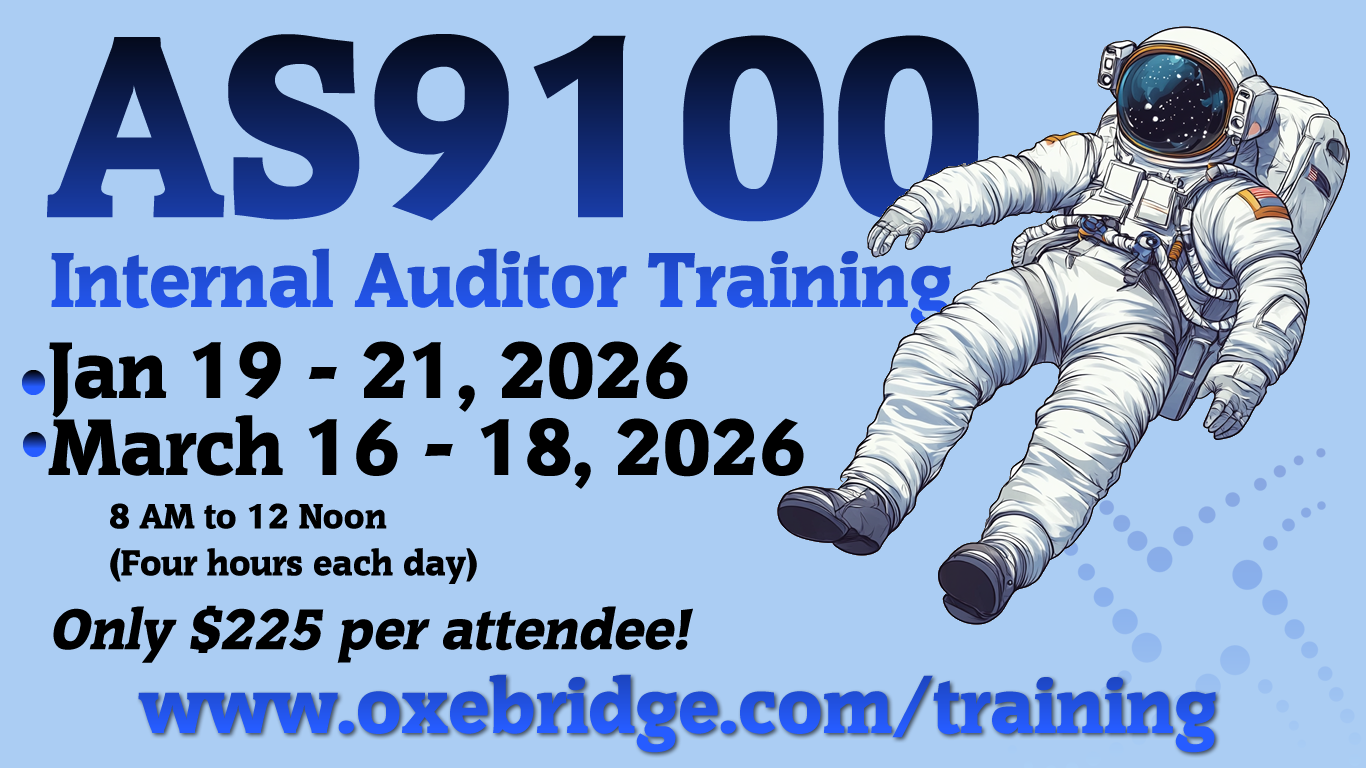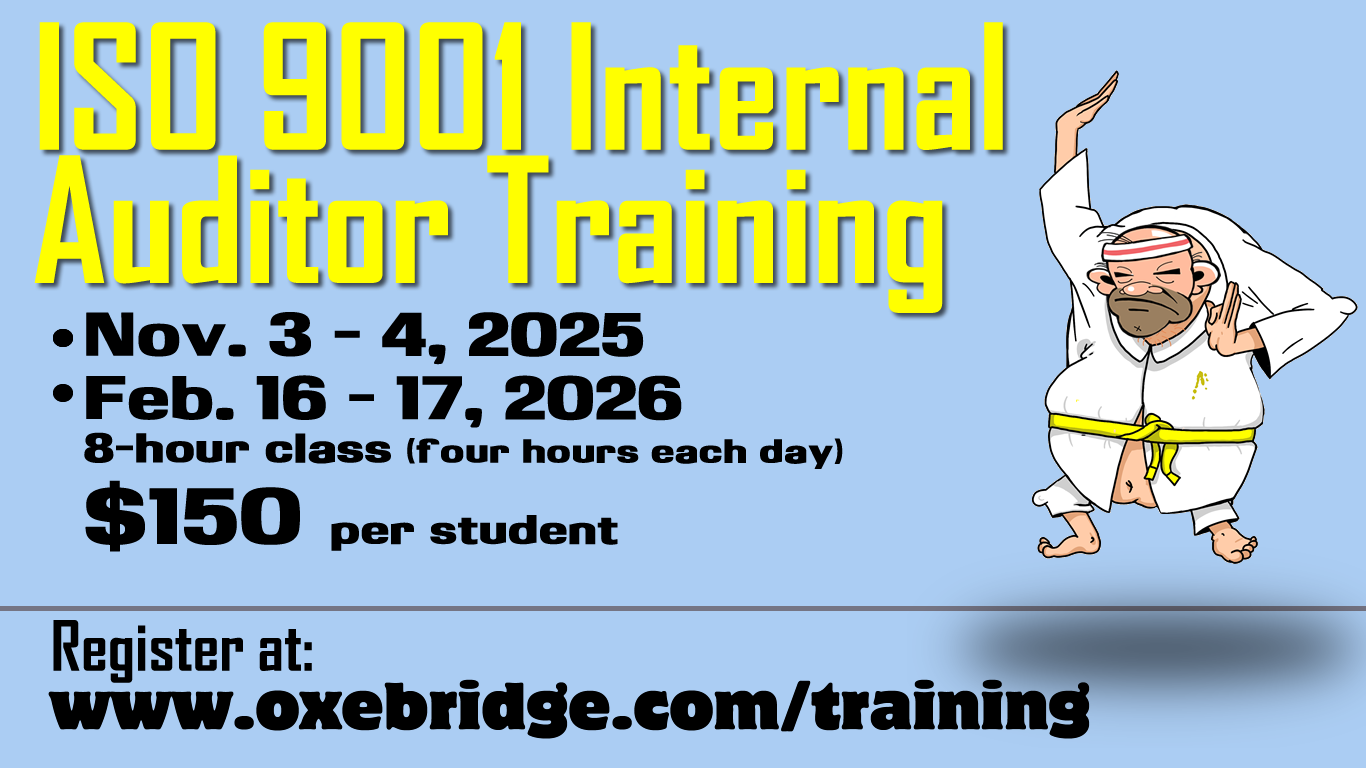Winter Haven FL — Responding to a formal request for clarification on the use of PEAR forms during AS9100 Rev C audits, the International Aerospace Quality Group (IAQG) has issued an opinion to Oxebridge.
The request for clarification came after numerous organizations, including Oxebridge clients, complained that under AS9100 Revision C, registrar auditors were either requesting or requiring that the clients fill out Process Effectiveness Assessment Report (PEAR) forms prior to, or during, their audits. In one case, an Oxebridge client spent over $10,000 in consulting fees and lost labor time to complete PEAR and turtle diagrams as directed by their auditor, even though the company had detailed process maps in their own format.
Oxebridge maintains that AS9101, the standard governing certification audits, clearly states this activity is to be done by the CB auditor.
Tim Lee of Boeing, and Chairman of the IAQG’s Registration Management Committee — the committee responsible for managing AS9100 certification body activities — issued the following statement in an email to Oxebridge VP Operations, Christopher Paris:
There is no requirement in AS9104-1 nor AS9101 for a client to complete a PEAR form, prior to an assessment. In addition, there is no requirement that prevents a CB from requesting that their clients complete the form as an audit prep activity. However, there is criteria that requires the Aerospace Audit Team to complete the required AS9101 forms and include them in their final audit report.
AS9101D states: 4.2.2.5 Identifying and Recording of Audit Findings [ISO/IEC 17021 clauses 9.2, 9.3, and 9.4; ISO 19011 clause 6.5.5]
The audit team shall record…………………
I am not sure if you have evidence that the forms completed by the client are actually included in the reports. If the answer is yes, then I encourage you to follow our AS9104/2 complaint process and provide your concerns to the CB and if not satisfied directly to the AB. We have a feedback process in OASIS that can be utilized to lodge the complaint. I can help facilitate your complaint if you provide me with examples.
In summary, we have no issue with the clients completing the forms. Actually, this may promote a better understanding of the requirements and the process approach. However, it is clear that the audit report must be generated by the Audit Team, including completion of the required forms.
Mr. Paris circulated the response to 10 client organizations and other professionals in the industry, all of whom had assisted with the original request for clarification. The result was a mixture of confusion and disappointment in the IAQG decision. In a written response to Mr. Lee, Oxebridge pointed out that Mr. Lee’s statement was, at first glance, a contradiction:
You stated the following:
“We have no issue with the clients completing the forms.”
and then:
“The audit report must be generated by the Audit Team, including completion of the required forms.”
The standard issues a clear requirement (auditors must complete the forms), but IAQG expands on that (allowing clients to complete the forms).
Mr. Paris summarized the best understanding of Mr. Lee’s position as a justification for having auditors merely transcribe evidence written by the client, which Oxebridge maintains is a serious breach of international accreditation standards, including ISO 17024.
The only way we can harmonize the contradiction is to interpret your decision as such: a client may complete the PEAR information prior to the audit, and that this information may then be accepted into the final audit report, provided the CB auditor merely transcribe it. This interpretation is supported by your request for examples where an un-transcribed version of a client form was included in a final report; an action you admit would be worthy of a formal complaint.
The response to IAQG goes on to cite three major problems with the response: first, that allowing clients to complete evidence forms prior to an audit negates the entire purpose of third party auditing; second, that the IAQG’s position that there “is no requirement” disallowing registrars from having clients fill out their own evidence is a dangerous precedent; and finally, that the PEAR form has not been established by any professional aerospace or process management organization as the “gold standard” by which clients may be taught process management, nor are CB’s allowed to “teach” clients as part of the audit activity.
Oxebridge has requested Mr. Lee and the RMC to take a more considered review.
“It doesn’t appear that the entire RMC was involved in the final decision,” Mr. Paris said. “I implore the IAQG to involve all stakeholders, including AS9100 user organizations, in a more formal review process.”
“I am confident the aerospace community would not be well served,” Mr. Paris continues, “by allowing clients or their consultants to fill out the final evidence of their own audits, and just having the auditors re-type them.”
Christopher Paris is the founder and VP Operations of Oxebridge. He has over 35 years’ experience implementing ISO 9001 and AS9100 systems, and helps establish certification and accreditation bodies with the ISO 17000 series. He is a vocal advocate for the development and use of standards from the point of view of actual users. He is the writer and artist of THE AUDITOR comic strip, and is currently writing the DR. CUBA pulp novel series. Visit www.drcuba.world







